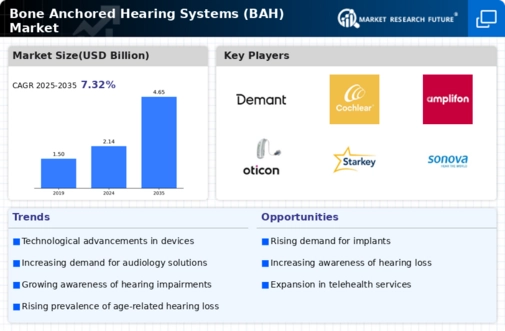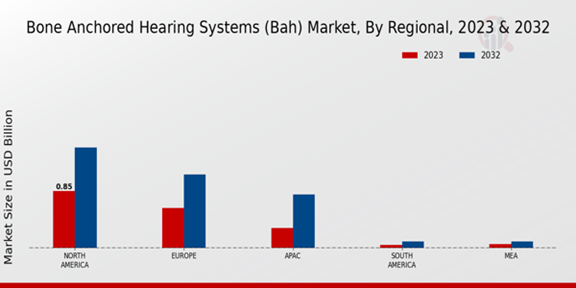Market Growth Projections
The Global Bone Anchored Hearing Systems (BAH) Market Industry is poised for substantial growth over the coming years. Projections indicate that the market will reach a valuation of 2.14 USD Billion in 2024 and is expected to expand to 4.65 USD Billion by 2035. This growth trajectory suggests a compound annual growth rate of 7.3% from 2025 to 2035. Such figures reflect the increasing demand for innovative hearing solutions driven by various factors, including technological advancements, demographic shifts, and heightened awareness of hearing health. The market's expansion underscores the critical role of BAH systems in addressing the needs of individuals with hearing loss.
Increasing Prevalence of Hearing Loss
The rising incidence of hearing loss globally is a primary driver for the Global Bone Anchored Hearing Systems (BAH) Market Industry. According to estimates, approximately 466 million people worldwide experience disabling hearing loss, with projections indicating this number could rise to over 900 million by 2050. This growing demographic creates a substantial demand for innovative hearing solutions, including BAH systems. As awareness of hearing health increases, more individuals are seeking effective treatment options, thereby propelling market growth. The Global Bone Anchored Hearing Systems (BAH) Market Industry is expected to reach a valuation of 2.14 USD Billion in 2024, reflecting the urgent need for advanced auditory devices.
Technological Advancements in Hearing Devices
Technological innovations in hearing devices significantly influence the Global Bone Anchored Hearing Systems (BAH) Market Industry. Recent developments in sound processing technology and miniaturization have enhanced the performance and comfort of BAH systems. For instance, advancements in digital signal processing allow for improved sound quality and noise reduction, making these devices more appealing to users. Furthermore, the integration of wireless connectivity features facilitates seamless interaction with smartphones and other devices. This trend is likely to attract a broader consumer base, contributing to the anticipated growth of the market, which is projected to reach 4.65 USD Billion by 2035.
Rising Awareness and Acceptance of Hearing Aids
There is a notable increase in awareness and acceptance of hearing aids, which positively impacts the Global Bone Anchored Hearing Systems (BAH) Market Industry. Public health campaigns and educational initiatives have played a vital role in reducing the stigma associated with hearing loss and the use of hearing devices. As more individuals recognize the importance of addressing hearing issues, the demand for BAH systems is likely to rise. This shift in perception is crucial, as it encourages early intervention and adoption of advanced hearing solutions. Consequently, the market is expected to experience substantial growth, driven by this evolving attitude towards hearing health.
Aging Population and Demand for Hearing Solutions
The global demographic shift towards an aging population is a crucial driver for the Global Bone Anchored Hearing Systems (BAH) Market Industry. As individuals age, the likelihood of experiencing hearing loss increases, necessitating effective auditory solutions. By 2030, it is estimated that one in six people will be aged 60 years or older, a demographic that often requires hearing assistance. This trend underscores the growing market potential for BAH systems, as older adults seek reliable and comfortable hearing solutions. The market is projected to grow at a compound annual growth rate of 7.3% from 2025 to 2035, reflecting the increasing demand for these devices among the elderly.
Government Initiatives and Funding for Hearing Health
Government initiatives aimed at improving hearing health are instrumental in shaping the Global Bone Anchored Hearing Systems (BAH) Market Industry. Various countries have implemented programs to enhance access to hearing care services, including funding for hearing devices. For example, some governments provide financial assistance for individuals requiring hearing aids, which can include BAH systems. Such initiatives not only alleviate the financial burden on patients but also promote the adoption of advanced hearing solutions. As these programs expand, they are likely to contribute to the overall growth of the market, fostering a more inclusive approach to hearing health.












